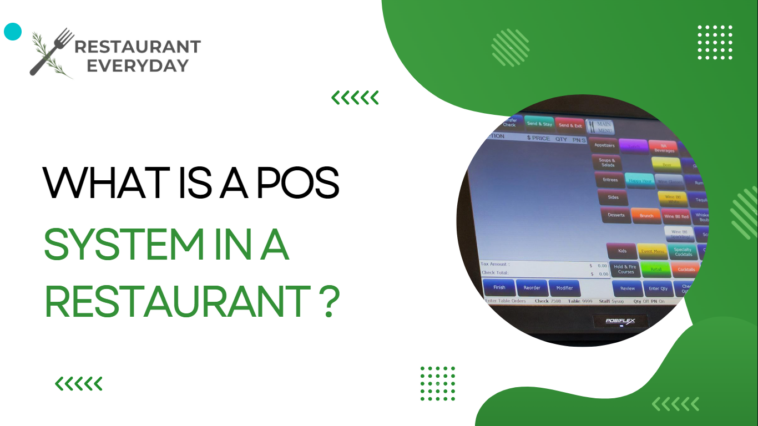In the intricate dance of managing a restaurant’s daily operations, the Point-of-Sale (POS) system emerges as a technological maestro, orchestrating seamless transactions and optimizing efficiency. What is a POS system in a restaurant? At its core, a POS system in a restaurant whether a fine dine, a roadside café or a pop-up restaurant, refers to the integrated hardware and software solution designed to facilitate and streamline various aspects of the business, from order processing and inventory management to payment transactions.
Gone are the days of handwritten orders and manual calculations; the modern restaurant POS system has become a central nervous system, intricately connecting front-of-house and back-of-house operations for a harmonious dining experience.
What is a POS system for a Restaurant?
A restaurant POS system encompasses a network of devices, typically including terminals, cash registers, and card readers, unified by sophisticated software. The hardware components, often featuring user-friendly touchscreen interfaces, empower restaurant staff to effortlessly navigate through the system, ensuring swift and accurate order processing. On the software side, the integration extends beyond mere transaction facilitation, encompassing order management, inventory tracking, employee scheduling, and robust reporting and analytics. In essence, a restaurant POS system is the heartbeat of modern dining establishments, pulsating with efficiency and accuracy.
Importance of POS system for a restaurant
Moving with time and advancements is the new trend of this global village. Therefore, the new tech toys like POS systems for your food and hospitality businesses hold great importance in prosperity and evolution. Following are the most crucial aspects of the POS system which make it withhold the high rank of demand.
- Pivotal Role in Modern Hospitality: POS systems play a pivotal role in the contemporary hospitality landscape, serving as a central component that significantly impacts the success of a restaurant.
- Meeting Elevated Customer Expectations: In an era where customer expectations are reaching new heights, POS systems are crucial in meeting these demands and providing a seamless and satisfying dining experience to the tech influenced and digital customers.
- Operational Efficiency as a Priority: Given the paramount importance of operational efficiency in the competitive restaurant industry, POS systems act as a game changer, facilitating streamlined processes and enhancing overall performance, ensuring customer satisfaction.
- Dynamic Solution for Challenges: These systems provide a dynamic solution, addressing challenges related to order management accuracy, inventory control efficiency, and communication improvement within different aspects of the restaurant i.e., FOH to the BOH.
- Enhanced Accuracy in Order Management: POS systems contribute significantly to the enhanced accuracy of order management, ensuring that customer orders are processed with precision and reducing the risk of human errors.
- Streamlined Inventory Control: Another key benefit is the streamlined control of inventory, allowing restaurants to keep track of stock levels in real-time, minimizing the risk of stockouts and optimizing supply chain management.
- Satisfying Experience for Patrons and Staff: The ultimate goal is to foster a more satisfying experience for both customers and restaurant staff, enhancing customer satisfaction while providing a more efficient and enjoyable working environment.
- Continued Relevance in Evolving Technology: As technology continues to evolve, the persistent importance of POS systems is highlighted, as they remain an instrumental tool for restaurants to keep pace with industry demands and set the stage for continued growth and innovation.
This article delves into the intricacies of restaurant POS systems, shedding light on their key components, functionalities, benefits, and future trends.
Key Components of a Restaurant POS System
We have enlisted the main elements of a restaurant POS system that will help you have a clear picture of what you will be getting served with.
Point-of-Sale Terminal
- Hardware Components: The backbone of a POS system includes a combination of devices such as terminals, cash registers, and card readers, all seamlessly working together to facilitate transactions.
- Touchscreen Interface: The user-friendly nature of touchscreen interfaces simplifies the order entry process, making it intuitive for restaurant staff to navigate through the system.
Software Integration
- Order Management: POS systems excel in streamlining order processing, allowing restaurants to efficiently manage customer orders from entry to fulfillment.
- Inventory Tracking: Keeping track of inventory in real-time enables better control over stock levels, reducing the likelihood of running out of crucial ingredients during peak hours.
- Employee Management: POS systems often include features for staff management, tracking working hours, and streamlining payroll processes.
- Reporting and Analytics: Robust reporting capabilities provide valuable insights into sales trends, customer preferences, and operational performance.
How does a Restaurant POS System Works
Point of Sale (POS) systems offer businesses a plethora of options and features that can be tailored to suit their individual requirements, ranging from dozens to even hundreds. The majority of these systems operate in the cloud, implying that all data is stored on a remote server rather than on a computer within the restaurant.
Whenever a server or guest places an order at the restaurant’s point of sale (POS), the system diligently records every detail of the transaction and synchronizes it with your inventory. The POS system enables the generation of various reports, providing valuable assistance when you aim to transition towards making data-driven business decisions.
Functionality and Features of a POS system for a Restaurant

When heading towards a change of dynamics you better be aware of all the features, technicalities and functions of the POS system for a restaurant.
Order Processing
- Menu Customization: POS systems empower restaurants to easily modify menus, add or remove items, and implement promotions or discounts.
- Table Management: Efficient table tracking features enable servers to assign orders to specific tables, reducing confusion and ensuring timely service.
- Order Modifications: POS systems allow for seamless order modifications, catering to customer preferences and dietary restrictions with precision.
Payment Processing
- Multiple Payment Options: Restaurants can accommodate various payment methods, including credit cards, mobile payments, and contactless transactions.
- Splitting Bills: The ability to split bills simplifies the payment process for groups along with easing the restaurant tipping process, enhancing overall customer experience.
- Contactless Payments: In an era of heightened hygiene awareness, contactless payment options have become a necessity, providing a safer and more convenient payment method for customers.
Benefits of Using a POS System in a Restaurant
From improved performance, to higher rates of efficacy, you name it and the restaurant POS system has that benefit.
Increased Efficiency
- Faster Order Processing: POS systems expedite the order-to-table process, minimizing wait times and improving overall restaurant efficiency.
- Improved Communication between Kitchen and Servers: Seamless communication between the front and back of the house ensures that orders are prepared accurately and delivered promptly.
Enhanced Accuracy
- Reduced Human Errors: Automation of the ordering process minimizes the risk of human errors, such as miscommunication between staff or inaccurate order entry or mismanaged restaurant service charges.
- Accurate Inventory Management: Real-time tracking of inventory levels helps prevent stockouts, ensuring that popular items are always available.
Streamlined Customer Experience
- Faster Checkout: Quick and accurate order processing leads to faster checkout, contributing to an overall positive dining experience for customers.
- Improved Customer Satisfaction: The seamless integration of POS systems into restaurant operations enhances customer satisfaction by minimizing errors and reducing wait times.
Integration of POS System with Other Restaurant Technologies
There has to be harmony among the operational systems in your restaurant that is why POS system has the integration feature to allow better execution.
Kitchen Display Systems (KDS)
The integration of POS systems with KDS streamlines communication between the kitchen and front-of-house staff, ensuring that orders are prepared and served efficiently.
Online Ordering and Delivery Platforms
POS systems play a pivotal role in managing online orders and integrating them seamlessly with in-house operations, providing a unified platform for order processing.
Loyalty Programs
POS systems enable the implementation of loyalty programs, allowing restaurants to reward repeat customers and gather valuable data on consumer preferences.
Considerations for Choosing the Right POS System
- Scalability : Restaurants should opt for POS systems that can scale with their business, accommodating growth and evolving operational needs.
- User-Friendly Interface : An intuitive and user-friendly interface is crucial for staff training and efficient daily operations, reducing the learning curve for new employees.
- Customization Options : The ability to customize menus, promotions, and reporting features ensures that the POS system aligns with the unique requirements of each restaurant.
- Cost and Affordability : Balancing the initial investment with long-term benefits is essential; restaurants should consider the total cost of ownership, including hardware, software, and ongoing support.
- Customer Support and Training : Access to reliable customer support and comprehensive training materials is crucial for successful implementation and ongoing use of a POS system.
Future Trends in Restaurant POS Systems
With leading advancements in the tech world there are a number of possibilities where the system would be integrated completely.
Artificial Intelligence Integration
The realm of Point-of-Sale (POS) systems is undergoing a transformative evolution through the integration of Artificial Intelligence (AI) technologies. This integration extends beyond mere transaction processing, aiming to revolutionize decision-making processes, automate routine tasks, and craft personalized customer experiences. AI algorithms embedded within modern POS systems analyze customer preferences, enabling targeted marketing strategies and suggesting upsells. Furthermore, these systems automate inventory management, predicting demand patterns and optimizing stock levels. By exploring the synergy between AI and POS, restaurants unlock a realm of possibilities for heightened operational efficiency and an enhanced customer journey.
Cloud-Based POS Solutions
In the dynamic landscape of restaurant management, the adoption of Cloud-Based POS Solutions emerges as a game-changer. This shift represents a departure from traditional, on-premise systems, offering unparalleled flexibility, accessibility, and scalability. Cloud-based POS solutions empower restaurants to adapt swiftly to changing business environments, allowing for seamless updates and reducing reliance on physical infrastructure. Moreover, the accessibility of real-time data from any location enhances decision-making and streamlines multi-location management. As the industry marches towards a more connected future, cloud-based POS solutions prove instrumental in fostering agility and resilience.
Data Security and Compliance
In an era where data is a prized asset, the discussion around POS systems cannot overlook the paramount importance of data security and compliance. As POS systems handle sensitive information, including customer details and payment data, addressing concerns related to privacy and regulatory compliance becomes imperative.
Restaurants must implement robust security measures within their POS systems, such as encryption protocols and secure payment gateways, to safeguard customer information. This discussion not only delves into the technical aspects of data security but also emphasizes the growing significance of adhering to industry regulations, ensuring the trust and confidence of both patrons and regulatory bodies.
Questions that you should ask before finalizing the POS system for your restaurant.
- What is the overall cost and affordability?
- Who provides customer support, and what is their reputation?
- How scalable is the POS system for future growth?
- Why are the POS system’s features crucial for your restaurant’s unique needs?
- Which interface aspects aid in smooth staff training and system integration?
Conclusion: What is a POS System in a Restaurant
In conclusion, the implementation of a robust POS system is pivotal for restaurants aiming to thrive in a competitive market. By embracing these technologies, businesses can not only streamline their operations but also elevate the overall dining experience for their customers. As technology continues to evolve, the role of POS systems in revolutionizing the restaurant industry and increasing restaurant sales is set to become even more prominent.




